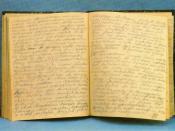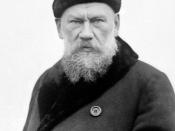Hannifin 1
Kelsey Hannifin
Mr. Kaminski
English 10, 1A
9 May 2014
Leo Tolstoy and the Romantic Era
In the early 1700s a new movement emerged from the Enlightenment period, the Romantic era, which lasted until the mid-nineteenth century. The Romantic mindset was prominent in writing through emphasizing the self, creativity, and imagination, which contrasted that of the Enlightenment. It was during this period that the Realist movement began in France in the 1840s, and eventually spread to the rest of Europe and to the Americas until around the 1890s. Realist writers, like Leo Tolstoy, focused on everyday life and its harsh reality instead of glorifying it, and criticized social conditions as well. Some of Leo Tolstoy's most known works are Anna Karenina and War and Peace. As a Russian realist, Tolstoy was influential to the Romantic period because of his contributions to literature through Realism, his own beliefs and values, and Pacifism throughout his works.
Leo Tolstoy was one of the first Russian writers to introduce a new type of literature and mindset to the era. The Romantic Movement had witnessed a shift from faith in reason during the Enlightenment era, to faith in imagination and the senses. Its literature tended to emphasize love of nature, valuing the natural man, and the Romantic belief that many of the flaws of society were a result of urbanization and heredity. Realism sharply contrasted with Romantic literature. Emile Zola defended his first novel against harsh accusations over its morality. His statement that his characters were 'dominated by nerves and their blood, deprived of free-will' provided for the key themes of realism (Mckay 815). Unlike romantics, realists did not glorify individual freedom or the individual itself. In the newfound manner of realist writing, characters were the center of interest as opposed to bystanders.


